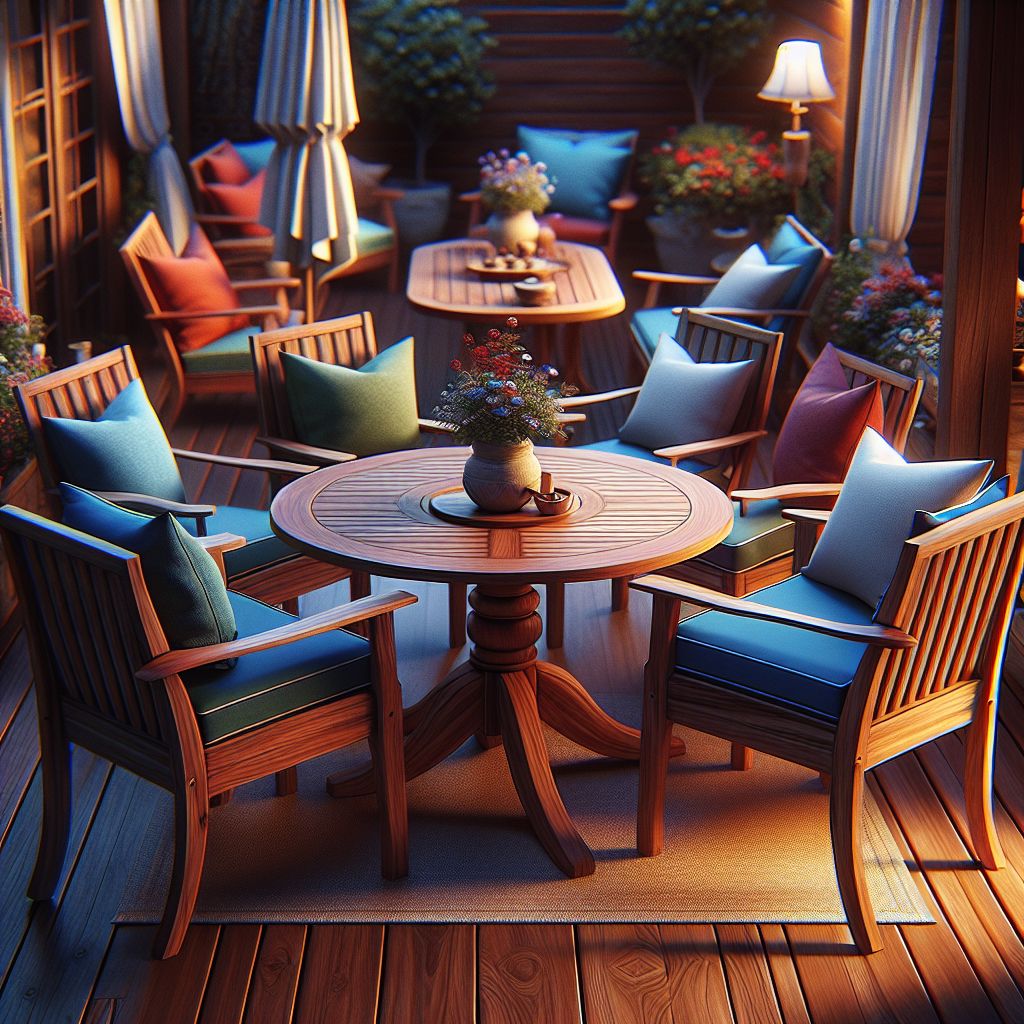
Key Takeaways
- Start by inspecting your furniture and cleaning it thoroughly before any refinishing work.
- Choose the right sandpaper grit and decide between manual or power sanding based on your furniture’s condition.
- Select stains and sealants that not only enhance the beauty but also protect the wood.
- Consider whether paint is a better option for your furniture and learn the best techniques for application.
- Understand the importance of regular maintenance to extend the life of your refinished furniture.
Your Patio, Your Masterpiece: Transforming Wood Furniture
Before we start, let’s make sure we have everything we need. Gathering the right materials is essential for a smooth refinishing process. Remember, quality tools and materials will result in a finish that’s both stunning and durable.
Gathering Your Materials
Having all your materials on hand means you won’t have to pause mid-project. Here’s what to gather:
- Sandpaper (80 to 220 grit)
- Power sander (optional but helpful for larger surfaces)
- Wood cleaner and soft bristle brush
- Clean rags for wiping down surfaces
- Quality wood stain
- Sealer or wood oil for protection
- Paint (if you’re going for a painted look)
- Protective gear (gloves, mask, safety glasses)
Once your materials are ready, it’s time to assess the type of wood you’re working with. Different woods have different needs and will respond to refinishing techniques in their own unique ways.
Understanding Your Wood Type
Teak, cedar, pine—each has its charm and challenges. Hardwoods like teak are incredibly durable but can be tougher to sand, while softwoods like pine might require a gentler touch. Knowing your wood type will guide your choices in cleaning, sanding, and sealing methods.
Hardwoods
- Oak
- Maple
- Cherry
- Walnut
- Mahogany
- Birch
- Ash
- Teak
Softwoods
- Pine
- Spruce
- Cedar
- Fir
- Redwood
- Douglas Fir

Refinishing Outdoor Wood Patio Furniture: A Step-by-Step Guide Plus Tips
Refinishing outdoor wood patio furniture is a rewarding project that can revitalize your outdoor space and prolong the life of your furniture. Follow these steps to tackle this rewarding project and transform your outdoor living space with ease.
Step 1: Furniture Inspection and Cleaning
Assessing the Damage
Before you sand away, take a good look at your furniture. Check for loose screws, rotten spots, or areas that need repair. It’s much easier to fix these issues now than after you’ve refinished the surface.
Examine each piece closely. If you find soft, rotting wood, you may need to replace it. For minor issues like cracks or splits, wood filler can be a handy solution. Tighten any loose parts to ensure your furniture is sturdy and ready for its makeover.
Cleaning before Sanding
Before we get to the sanding, we need to clean. Years of outdoor living can leave dirt, algae, or old sealants that will hinder your refinishing efforts. Use a wood cleaner and a soft brush to scrub the surface clean, then rinse with water and let it dry completely. A clean surface ensures your sanding and staining efforts won’t go to waste.
Remember, this isn’t just about making your furniture look good; it’s about creating a space that reflects who you are. And the first step to doing that is ensuring a clean, solid foundation.
Sanding Tips for an Even Finish
Now, let’s focus on sanding. It’s more than just an arm workout—it’s the step that determines how smooth and welcoming your furniture will feel. Start with a coarser 80-grit sandpaper to remove the old finish and smooth out any rough patches. Then, work your way up to a finer 220-grit for a satiny finish. Always sand in the direction of the wood grain to avoid scratches that could mar the final appearance.
Step 2: Staining and Sealing: Adding Character and Protection
Selecting the Perfect Stain
Choosing the right stain is incredibly important. Consider the original color of your wood and the final look you’re aiming for. Do you want to enhance the natural color, or are you looking for a dramatic change? Oil-based stains penetrate deeply, offering rich color and moisture resistance, while water-based stains are easier to clean up and offer a wider range of colors.
Staining isn’t just about color; it’s about depth and warmth. It can transform a plain piece of wood into a rich tapestry of tone and texture. But before you pop open that can of stain, make sure your wood is completely dry from the cleaning process. Moisture is the enemy of a smooth, even stain.
Applying Stain Evenly
When applying stain, work in sections and use a brush or rag, moving along with the grain. Apply it liberally, and don’t be afraid to go over the same area a few times to ensure full coverage. After about 15 minutes, wipe off any excess with a clean cloth. This will prevent any uneven, sticky patches from ruining your hard work.
For an even coat, apply the stain with a brush, following the wood’s natural lines. If you’re working on a large surface, a staining pad can help cover more area with consistent pressure. Remember to blend your edges as you go to avoid harsh lines. The key is to work swiftly but carefully, maintaining a wet edge to blend the new stain with the old smoothly.
The Art of Sealing
Once the stain has dried, it’s time to seal the deal. A good sealer protects your furniture from the elements and wear and tear. It also adds a beautiful sheen that can either be glossy or matte, depending on your preference. Apply the sealer with a clean brush, working in long, even strokes. This top coat is your furniture’s shield, so make sure to cover every nook and cranny.

Step 3: Let’s Paint: Colorful Possibilities
If stain isn’t your style, paint offers a world of colorful possibilities. From a bright pop of color to a subtle, muted hue, paint can completely alter the vibe of your outdoor space. But before you start, make sure to use a primer designed for outdoor use. This will help your paint adhere better and last longer, standing up to the rigors of outdoor life.
Picking a Paint that Lasts
When selecting paint, opt for products labeled for exterior use, which are formulated to withstand UV rays and weather conditions. Acrylic latex paints are a popular choice for their durability and easy cleanup. You’ll want to apply at least two coats for a solid, even color, letting it dry thoroughly between applications.
Brushwork Techniques for a Professional Look
Your brushwork can make or break the final look. For a professional finish, use a high-quality brush that won’t shed bristles. Start with the detailed areas, using a smaller brush to get into crevices. Then, switch to a larger brush for broad surfaces, always painting with the grain. Smooth, even strokes are the secret to a finish that looks like it was done by a pro.
Step 4: Finishing Touches: Hardware and Details
With the painting or staining complete, it’s time to focus on the finishing touches. This is where your furniture really starts to shine and reflect your personal touch.
Reviving or Replacing Hardware
When it comes to reviving existing hardware, a bit of steel wool and metal polish can bring back the shine. If the hardware is beyond saving, replacing it is a simple but effective way to update the look of your furniture.
For example, if you’re working on a vintage piece, look for hardware that matches the era. Or, for a modern twist, go for hardware with clean lines and a brushed metal finish. It’s these little details that can make a world of difference.
In the end, the effort you put into refinishing your outdoor wood furniture is more than just a weekend project. It’s an act of care that not only beautifies your space but also extends the life of the pieces you’ve grown to love. With these steps, tips, and a bit of elbow grease, you’re well on your way to creating an outdoor haven that’s uniquely yours.
Add Cushions or Pillows
Adding cushions or pillows to newly refinished patio furniture is an excellent way to introduce a pop of color and refresh the overall look of your outdoor space. Vibrant or patterned cushions not only enhance comfort but also create an inviting atmosphere, making your patio a more enjoyable place to relax and entertain. This simple addition can transform your newly refinished patio furniture into a stylish and cozy retreat, blending functionality with aesthetic appeal.
Consider Protective Covers
Consider using protective covers for your patio furniture during periods when it’s not in use. These covers help shield against weather damage, dirt, and sun fading, significantly extending the life of your furniture. Investing in high-quality covers is a practical way to maintain the condition and appearance of your outdoor pieces, ensuring they remain pristine and vibrant for years to come.

Nurture and Maintain: Prolonging the Life of Your Creation
Just like a garden, your newly refinished wood furniture requires regular upkeep to stay vibrant and strong. The work doesn’t end with the last coat of sealer; it continues with ongoing care that will ensure your pieces can weather the seasons ahead.
Regular Maintenance Tips
Consistent, gentle cleaning is the key to maintaining the integrity of your furniture’s finish. A soft cloth or brush with a bit of soapy water is usually all you need for routine cleaning. Immediately tend to any spills or stains to prevent them from setting in.
Once a year, give your furniture a more thorough inspection. Tighten any loose screws, check for signs of wear, and apply a fresh coat of sealer if necessary. This annual check-up can prevent small issues from becoming big problems and can significantly extend the life of your furniture.
Seasonal Care for Wood Furniture
Seasonal shifts bring new challenges for outdoor furniture. Before winter sets in, ensure that all your furniture is clean and dry. If you’re in a region with harsh winters, store your furniture indoors or cover it securely. Come spring, a light sanding and a new coat of sealant can refresh your furniture and prepare it for another year of enjoyment.

Frequently Asked Questions (FAQ)
How often should outdoor wood furniture be refinished?
Typically, outdoor wood furniture should be refinished every 2-3 years, but it really depends on the level of exposure to the elements and the type of wood. Regular maintenance can sometimes extend this timeframe.
Can I refinish furniture without stripping old paint or stain?
If the existing finish is in good condition and you’re not making a drastic color change, you can often get away with a thorough cleaning and light sanding before applying a new topcoat. However, if the old finish is peeling or flaking, stripping it down is necessary for a lasting finish.
What’s the best way to protect refinished furniture from the elements?
The best protection is a combination of a quality sealant and practical measures like using furniture covers or storing pieces away from direct sunlight and moisture. Sealants should offer UV protection and be appropriate for the type of wood you’re working with.
Is it better to stain or paint outdoor wood furniture?
It’s a matter of personal preference and the look you’re aiming for. Stain enhances the wood’s natural beauty, while paint provides a solid, uniform color. Consider the environment, too; stain might be better for a rustic setting, while paint could suit a more contemporary space.
What safety precautions should I take when refinishing wood furniture?
Always work in a well-ventilated area and wear protective gear, including gloves, a mask, and safety glasses. Read all product labels for specific safety recommendations, and keep your work area clean to avoid accidents.
By following this comprehensive guide, you’re not just refinishing furniture; you’re creating a legacy of beauty and functionality that can be enjoyed for years to come. The effort you invest now will pay dividends in countless hours of relaxation and pride in your outdoor space. So, go ahead, make your mark and enjoy the fruits of your labor in a refreshed, personalized patio haven.





Leave a Reply